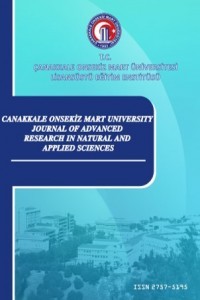Aharonov-Bohm Olayı ve Monopol
Aharonov-Bohm, Ayar Dönüşümü, Dirac Kuantizasyonu, Saçılma, Tek-kutup (Monopol)
Aharonov-Bohm Effect and Monopole
Aharonov-Bohm, Dirac Quantization, Gauge Transformations, Scattering, Monopole,
___
- Aharonov Y., Bohm D., 1959. Significance of Elektromagnetic Potentials in the Quantum Theory. Physical Review 115: 485.
- Alvarez-Gaume L., Hassan S.F., 1997. Introduction to S-Duality in N=2 Supersymmetric Gauge Theories. Fortsch. Phys. 45: 159-236.
- Chambers R.G., 1960. Shift of an Electron Interference Pattern by Enclosed Magnetic Flux. Physical Review Letters 5: 3.
- Dirac P.A.M., 1931. Quantised Singularities in the Electromagnetic Field. Proceedings of the Royal Society of London A 133: 821.
- Dirac P.A.M., 1948. The Theory of Magnetic Poles. Physical Review 74: 817.
- Gasiorowicz S., 1974. Quantum Physics. John Wiley and Sons, Singapore. 514 p.
- Gradshteyn I. S., Ryzhik I.M., 2000. Table of Integrals, Series, and Products (6th ed.). Academic Press, United States of Amerika. 1163 p.
- Goldstein H., Poole C., Safko J., 2002. Classical Mechanics (3rd ed.). Addision Wesley, United States of Amerika. 638 p.
- Jackson J.D., 1999. Classical Electrodynamics (3rd ed.). John Wiley and Sons, Inc., New York. 808 p.
- Möllenstedt G., Bayh W., 1962. Kontinuierliche Phasenschiebung von Elektronenwellen im kraftfeldfreien Raum durch das magnetische Vektorpotential eines Solenoids. Physikalische Blatter 18: 299-305.
- Page L., 1930. Deflection of Electrons by a Magnetic Field on the Wawe Mechanics. Physical Review 36: 444.
- Peshkin M., Tonomura A., 1989. The Aharonov – Bohm Effect (Lecture Notes in Physics). Springer – Verlag, Berlin Heidelberg. 153p.
- Polchinski J., 2004. Monopoles, Duality, and String Theory. Int. J. Mod. Phys. A 19: 145-156.
- Preskill J., 1984. Magnetic Monopoles. Annual Review of Nuclear and Particle Science 34: 461-530.
- Sakurai J.J., 1994. Modern Quantum Mechanics. Addison-Wesley Publishing Company, Inc., United States of America. 513 p.
- Schiff L. I., 1949. Quantum Mechanics. McGraw-Hill Book Company, Inc., New York Toronto London. 417 p.
- Schwinger J., 1966. Magnetic Charge and Quantum Field Theory. Physical Review 144: 1087-1093.
- Schwinger J., 1968. Sources and Magnetic Charge. Physical Review 173: 1536-1544.
- Tai-Pei Cheng and Ling-Fong Li, 1984. Gauge Theory of Elemantary Particle Physics. Oxford University Press, New York. 536 p.
- Thomson J.J., 1904. Elements of the Mathematical Theory of Electricity And Magnetism (3rd ed.). Cambridge University Press, England. 550 p.
- Thomson J.J., 1904. On Momentum in the Electric Field. Philosophical Magazine 8: 331.
- Tonomura A., Matsuda T., Suzuki R., Fukuhara A., Osakabe N., Umezaki H., Endo J., Shinagawa K., Sugita Y., Fujiwara H., 1982. Observation of Aharonov-Bohm Effect by Electron Holography. Physical Review Letters 48: 1443.
- Tonomura A.,Osakabe N., Matsuda T., Kawasaki T., Endo J., Yano S., Yamada H., 1986. Evidence for Aharonov-Bohm Effect with Magnetic Field Completely Shielded from Electron Wawe. Physical Review Letters 56: 792.
- Wu T. T., Yang C. N., 1975. Concept of nonintegrable phase factors and global formulation of gauge fields. Physical Review D 12: 3845.
- Wu T. T., Yang C. N., 1976. Dirac monopole without strings: Monopole harmonics. Nuclear Physics B 107: 365-380.
- Yilmaz O., 2014. Scattering of a Changed Particle from a Hard Cylindrical Selenoid: Aharonov-Bohm Effect. Chinese Journal of Physics 52: 1184-1198.
- Yayın Aralığı: Yılda 4 Sayı
- Başlangıç: 2015
- Yayıncı: Çanakkale Onsekiz Mart Üniversitesi
Çanakkale İli Sphingidae (Lepidoptera) Türleri Üzerine Faunistik Araştırmalar
Papatya TİFTİKCİ, Serpil KORNOŞOR
Su Arıtımında Ultrases Uygulaması: Arıtma Yöntemlerine Farklı Bir Yaklaşım
Harika Eylül ESMER, Güllü KAYMAK, Şeyma TARTAR, Figen Esin KAYHAN
V1095 Her ve V1101 Her Sistemlerinin Dönem Değişimleri
Oğuz ÖZTÜRK, Ahmet ERDEM, Fahri ALİÇAVUŞ
Süt Somatik Hücre Sayısının E-Burun ile Belirlenmesi
Melis İNALPULAT, Ünal KIZIL, Ertuğrul BİLGÜCÜ, Levent GENÇ
